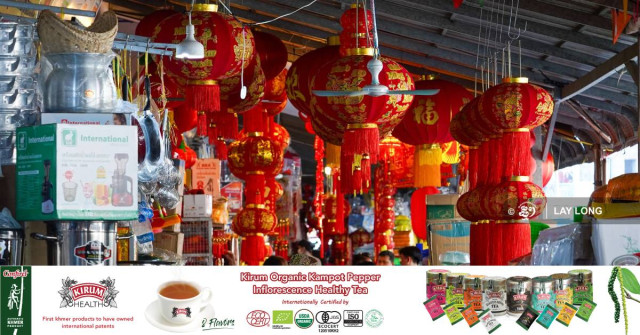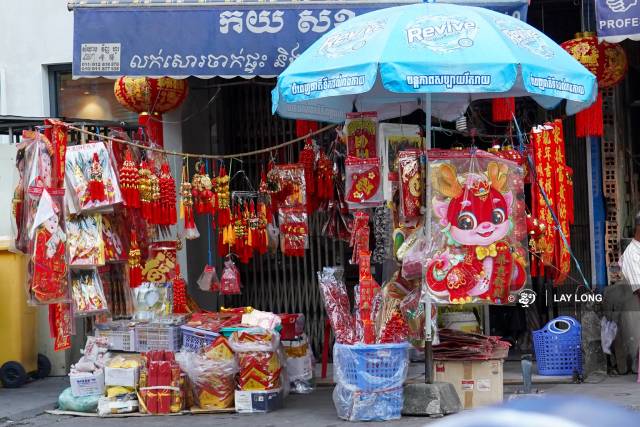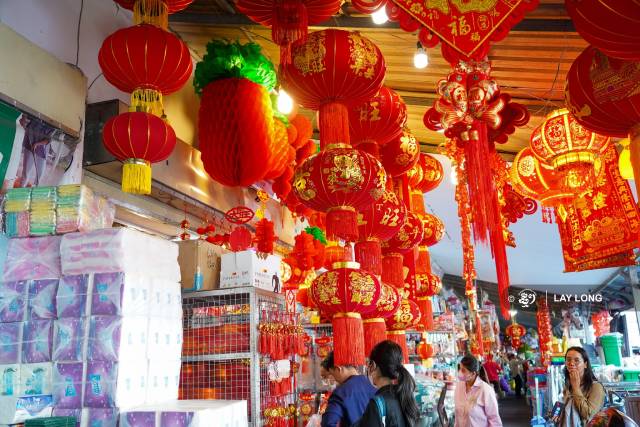Customs for Chinese New Year Celebrations

- By Rin Ousa
- February 9, 2024 8:50 AM
PHNOM PENH – As Chinese New Year approaches, Cambodians with Chinese ancestry start decorating their houses to honor ancestors and set the scene for family gatherings.
A few days before the celebration, they put up red lanterns, Chinese couplets, and flowers such as sbay roeung.
Av Nonn, a feng shui teacher in Phnom Penh said red has great significance in Chinese culture as it brings success, happiness and good fortune to each individual and household.
Following are some customs of Chinese New Year, some taboos on New Year’s Day and popular recipes.

Spring Festival Couplets
Traditionally, doorways are decorated with spring festival couplets. The couplets have a horizontal scroll at the top and two vertical scrolls on each side of doorways. In ancient times, these couplets were made of peach wood as it was believed this could protect against evil spirits.
Later, red paper began to be used and this looks better and more festive. The words on couplets express best wishes for the new year.
Decoration of Lanterns
Red and gold lanterns are hung in front of houses as they symbolize hope, prosperity and good fortune. Lanterns are often given as gifts because it is believed that they will protect against evil spirits and bring good fortune.

Samlor Chab Chay - Chab Chay Soup
Samlor chab chay is believed to be an indispensable recipe during Chinese New Year for honoring ancestors, Av Nonn said.
“This soup was made with many kinds of vegetables and meat. It was kept for three days to a week for eating. However, the ingredients vary in the present time according to the family's economic situation.
“Before, every household combined all the leftover foods into that soup for eating, that’s why it is called chab chay - a mixture of things,” he said.
Av Nonn said the smell from chab chay soup can bring luck and happiness to the family. In ancient times, this soup was cooked in earthenware to keep it hot. It is believed that while honoring the ancestors, the smell from the soup when opening earthenware cover could bring a family good fortune, happiness and best wishes throughout the year.

Flowers and Plants
Ochna integerrima flower is widely used among Cambodian people with Chinese descendants. This flower, with its beautiful spring blooms, held great significance in Chinese culture in the old days.
“When Ochna integerrima flower is blooming, the good smell from the flowers can bring good fortune to the family,” Av Nonn said.
“In addition to Ochna integerrima, sbay roeung flowers are also commonly used in the present due to their yellow color which symbolize wealth, prosperity and good luck.
“Miniature orange trees symbolize happiness and get protection from their ancestors,” he said.
_1707384892.jpg)
Red Envelope
On Chinese New Year’s Eve, a red envelope is commonly given to parents, grandparents and young people. However, people who are not married should not give envelopes to others. It is believed that when giving red envelopes to them, money will be increasing throughout the year.
Chinese New Year Taboos
During the three days of Chinese New Year, Av Nonn said sweeping the floor and cleaning the house are not allowed as it could sweep away wealth. Taking out the trash means dumping good fortune.
Additionally, he said quarrels should be avoided as these could bring bad luck to the family. Using unlucky words which are related to death, sickness, ghosts or poverty should also be prohibited during that period.
Nowadays, washing dishes is allowed because people can’t leave dirty dishes for three days. However, you must not break items such as bowls and glass because this would be a sign of bad luck and separateness.
Chinese New Year, the Year of the Dragon, will be celebrated from Feb. 9 with the New Year starting on Feb. 10.















